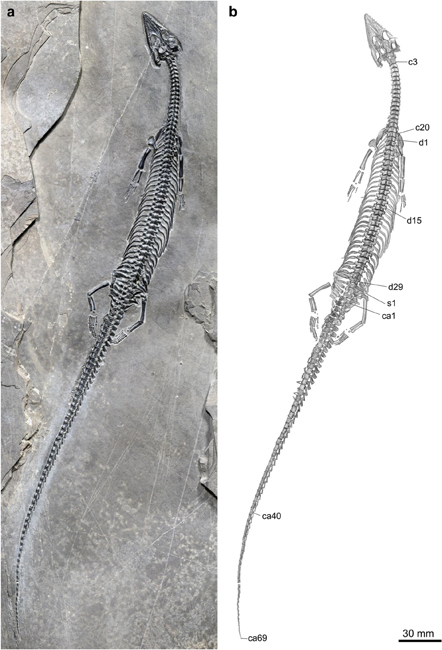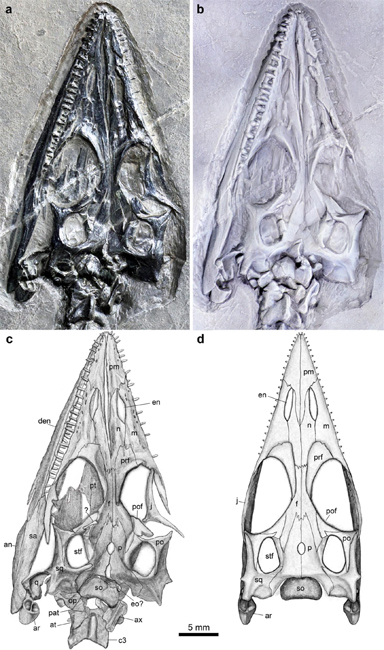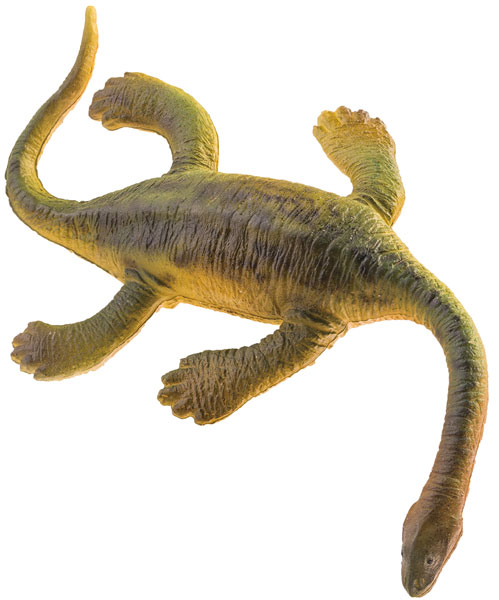A new species of Triassic marine reptile has been described following the discovery of superbly preserved fossils in Yunnan Province (south-western China). Named Honghesaurus longicaudalis it is a member of the Pachypleurosauroidea and it possessed the longest tail of any known pachypleurosaur.

The holotype fossil (IVPP V30380) of the newly described Honghesaurus longicaudalis. Photo (a) and line-drawing (b) of whole specimen. c, cervical vertebra; ca, caudal vertebra; d, dorsal vertebra; s, sacral vertebra. Picture credit: Xu et al.
Picture credit: Xu et al
Writing in the academic journal “Scientific Reports”, the researchers from the Chinese Academy of Sciences, in collaboration with colleagues from the Zhejiang Museum of Natural History and Guizhou University, describe a complete skeleton in the collection of the Institute of Vertebrate Palaeontology and Palaeoanthropology, Chinese Academy of Sciences (specimen number IVPP V30380). The stunning fossil material comes from marine deposits associated with the Guanling Formation and it is estimated to be around 244 million years of age (Anisian stage of the Middle Triassic).
The Tale of a Very Long Tail
Remarkably, the tail of H. longicaudalis contains 69 caudal vertebrae, far more than any other known pachypleurosaur, other pachypleurosaurs commonly have no more than 58 caudal vertebrae. Humans in comparison have just 33 vertebrae in their skeleton. The researchers conclude that this extremely long tail (making up more than fifty percent of the entire body length), in combination with the animal’s long trunk made Honghesaurus extremely manoeuvrable in water. The scientists also speculate that the exceptionally long tail and body helped this marine reptile to conserve energy as it swam.

Skull and mandible of Honghesaurus longicaudalis (IVPP V30380). Photo before (a) and after (b) dusted with ammonium chloride. (c) Line- drawing. (d) Reconstruction in dorsal view. an, angular; ar, articular; at, atlas; ax, axis; c, cervical vertebra; den, dentary; en, external naris; eo, exoccipital; f, frontal; j, jugal; m, maxilla; n, nasal; op, opisthotic; p, parietal; pat, proatlas; pm, premaxilla; po, postorbital; pof, postfrontal; prf, prefrontal; pt, pterygoid; q, quadrate; sa, surangular; so, supraoccipital; sq, squamosal; stf, supratemporal fossa. Picture credit: Xu et al.
Picture credit: Xu et al
The Dispersal of the Pachypleurosaurs
The holotype and currently only known specimen of H. longicaudalis (IVPP V30380) measures 47.1 cm in length. Most pachypleurosaurs were of a similar size although phylogenetic analysis suggests that Honghesaurus was closely related to the much larger Wumengosaurus delicatomandibularis, which had an estimated body length of 1.3 metres.
Pachypleurosaurs are regarded as basal members of the Superorder Sauropterygia, which includes placodonts and the plesiosaurs. The research team postulate that the discovery of Honghesaurus demonstrates the diverse morphology of the Pachypleurosauridae and lends weight to the idea that these marine reptiles originated in Europe and dispersed along the Tethys Ocean in a westerly direction giving rise to new forms in the eastern Tethys Ocean.

The best-known of all the pachypleurosaurs is Keichousaurus. It is also known from south-western China although from geologically younger deposits than the strata that yielded the single specimen of Honghesaurus.
The picture (above) shows a PNSO Keichousaurus model. To view the range of PNSO prehistoric animal models: PNSO Age of Dinosaurs Figures.
The scientific paper: “A long-tailed marine reptile from China provides new insights into the Middle Triassic pachypleurosaur radiation” by Guang-Hui Xu, Yi Ren, Li-Jun Zhao, Jun-Ling Liao and Dong-Hao Feng published in Scientific Reports.






Leave A Comment